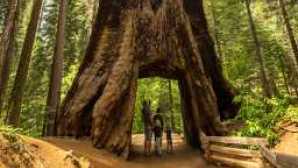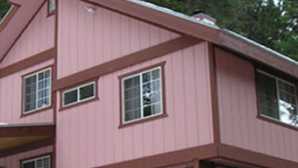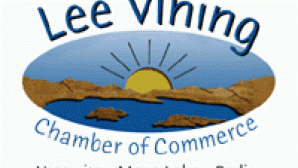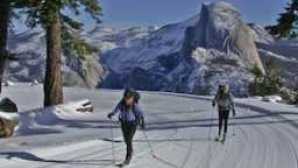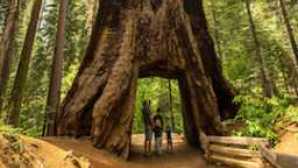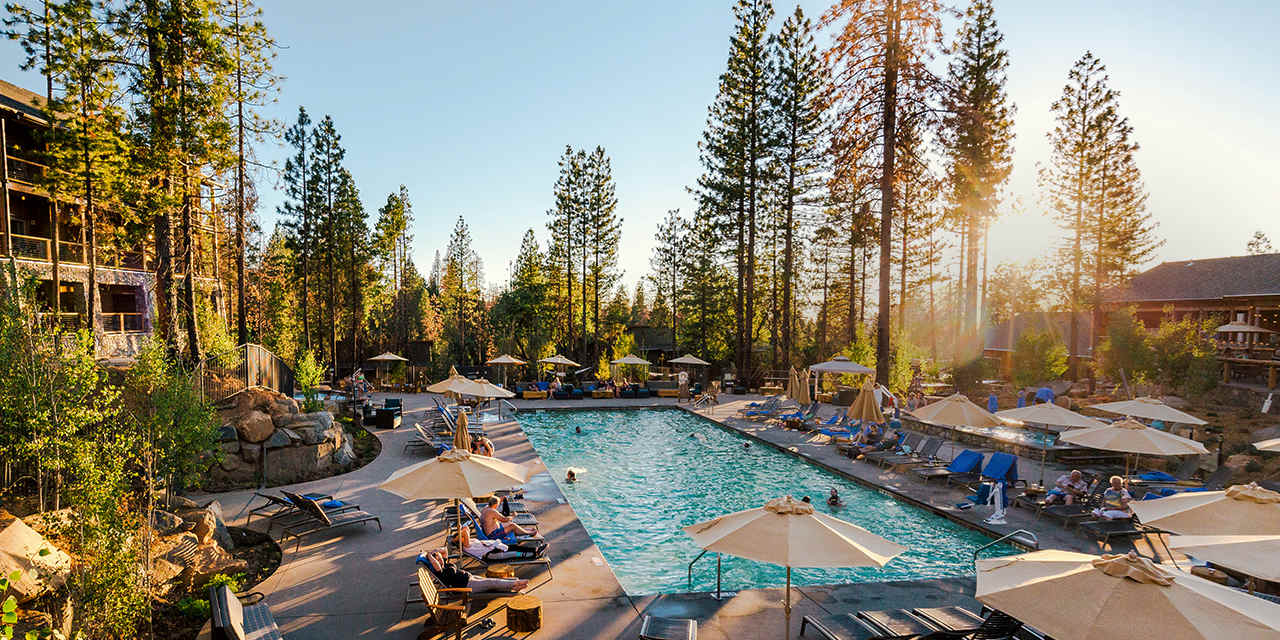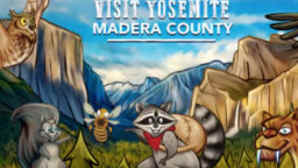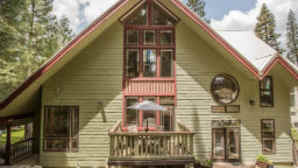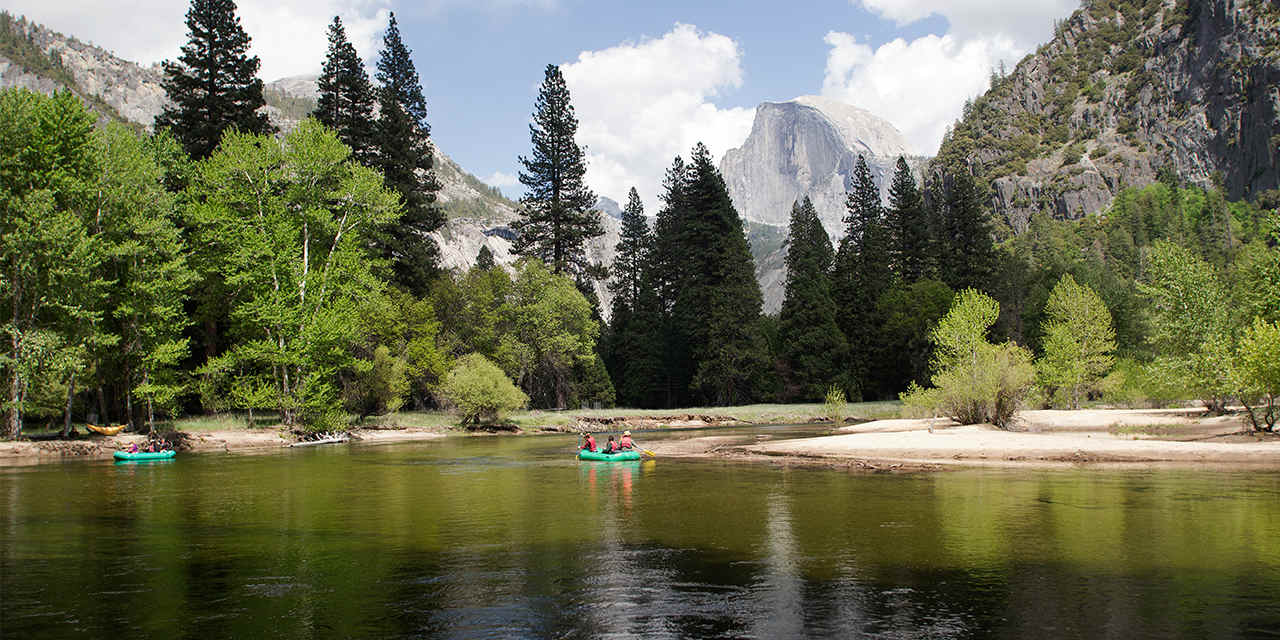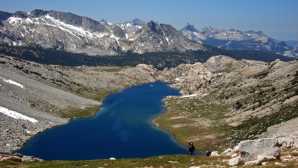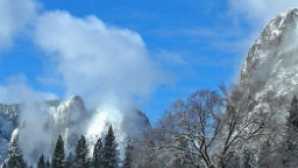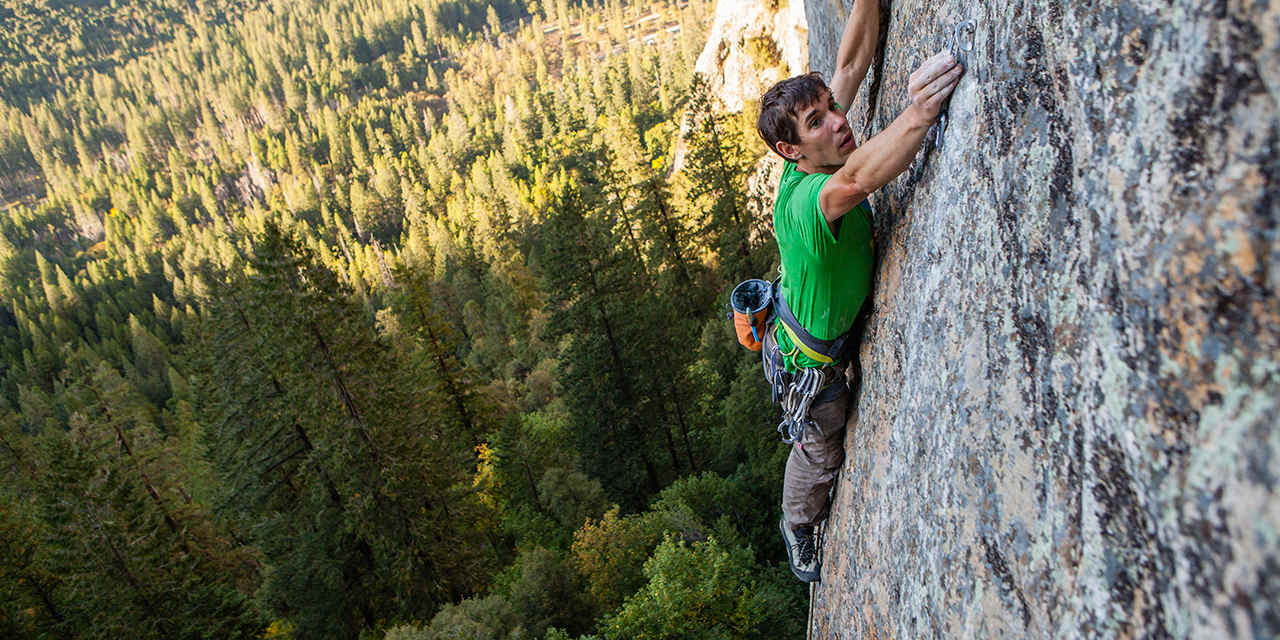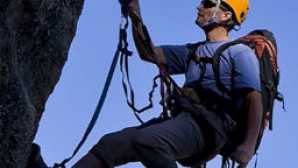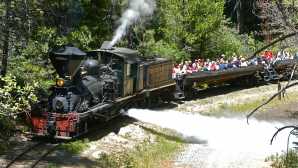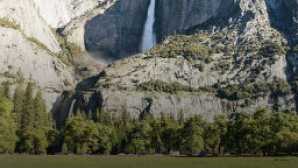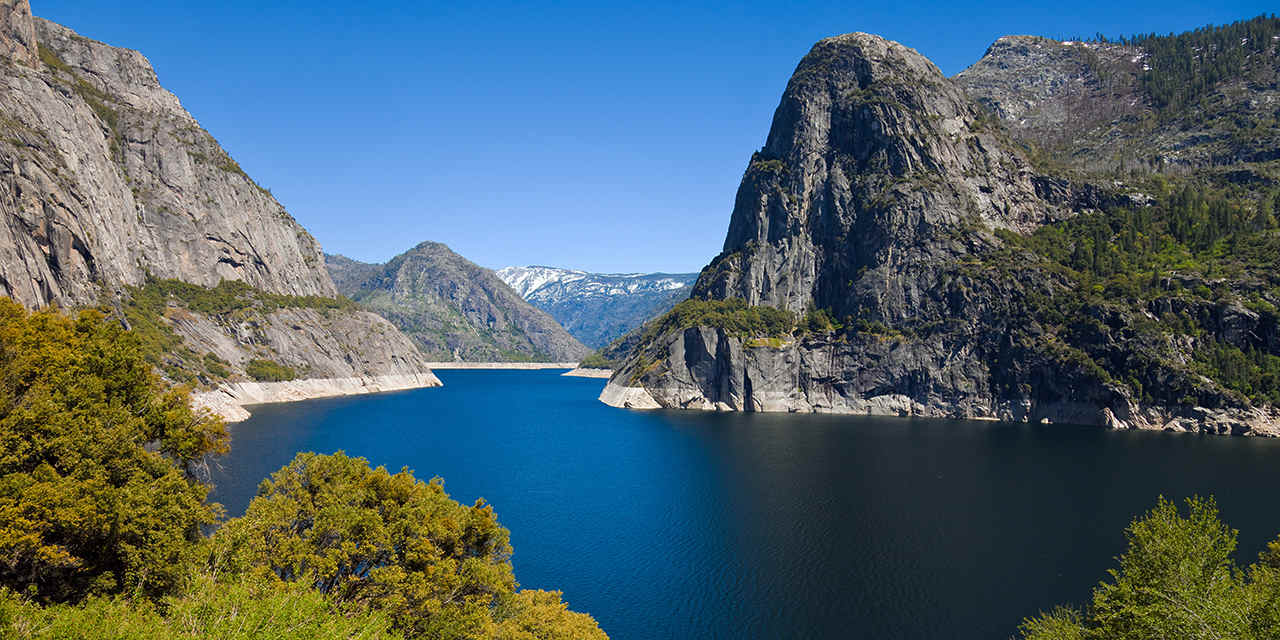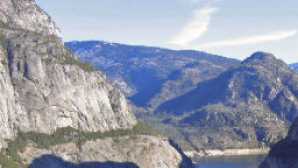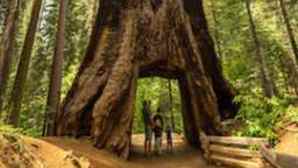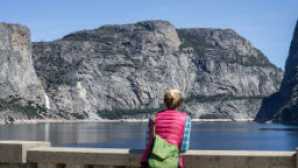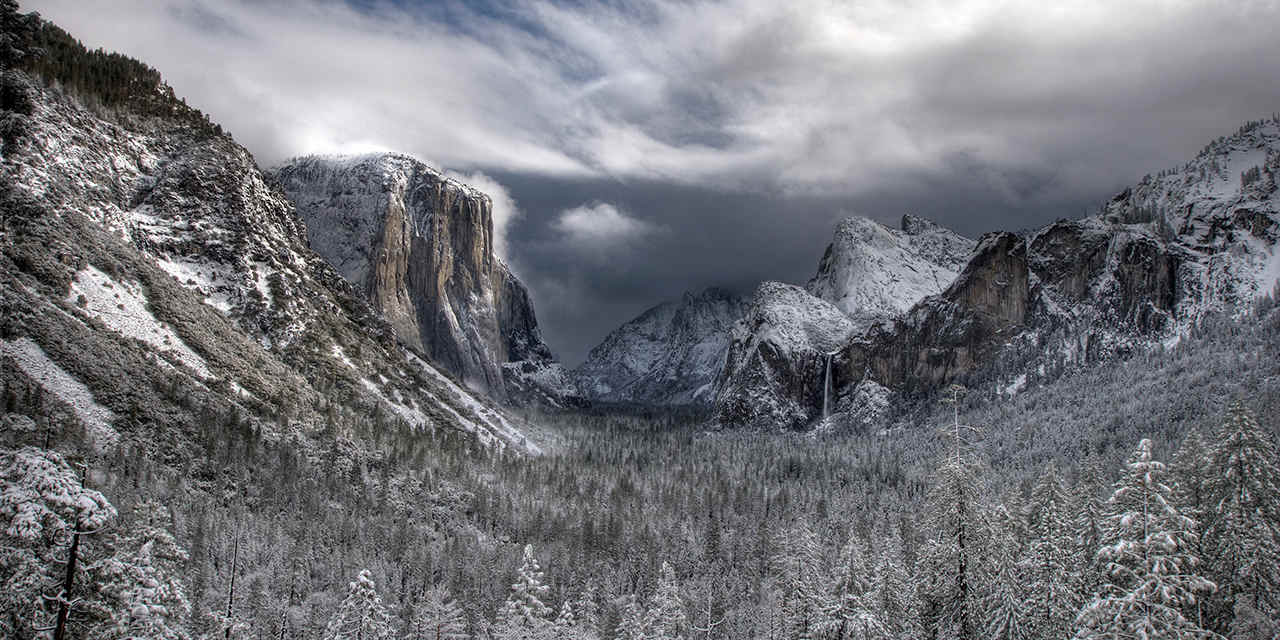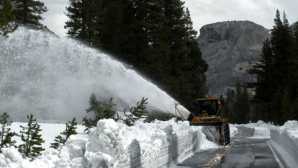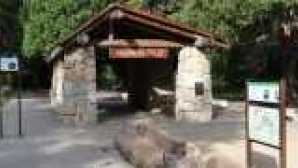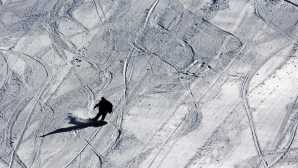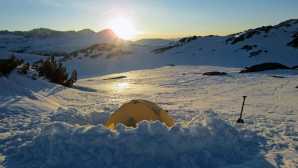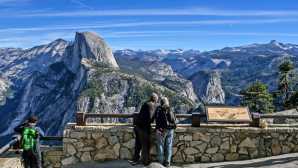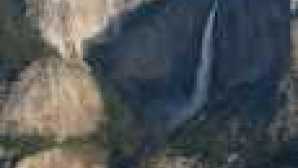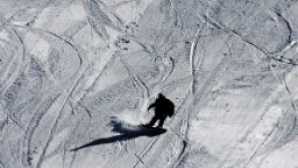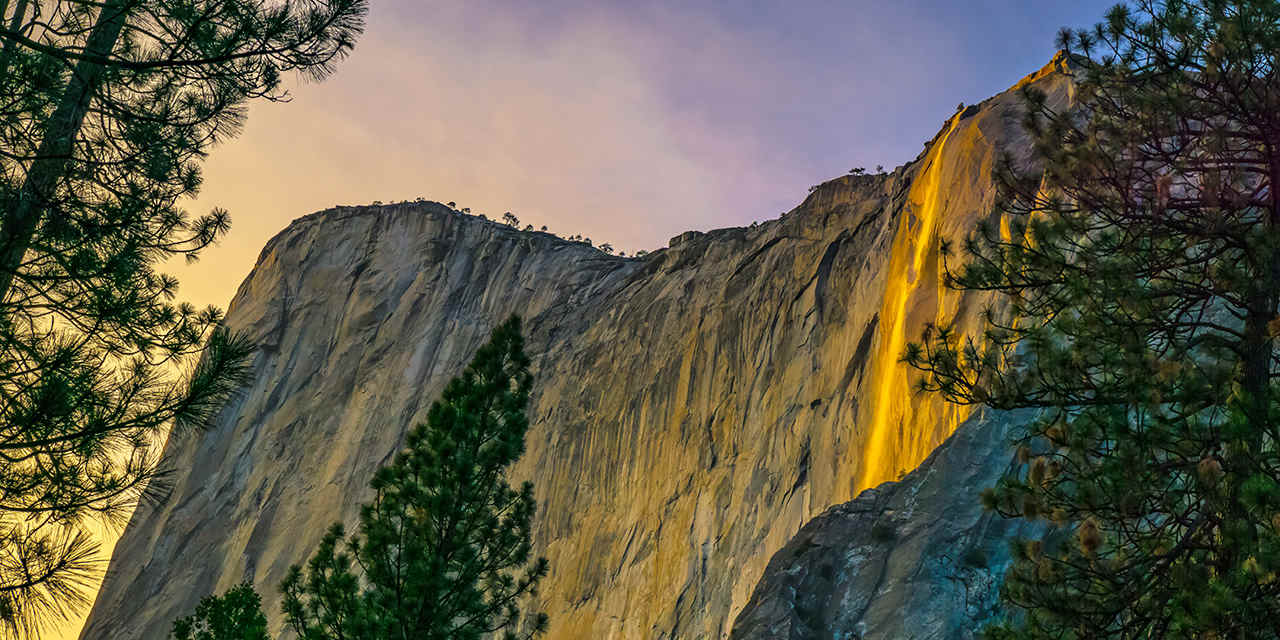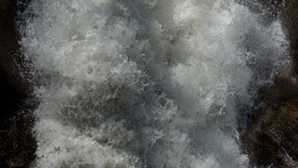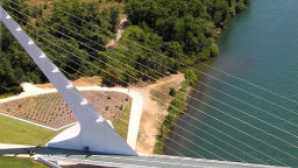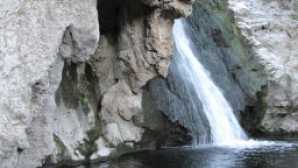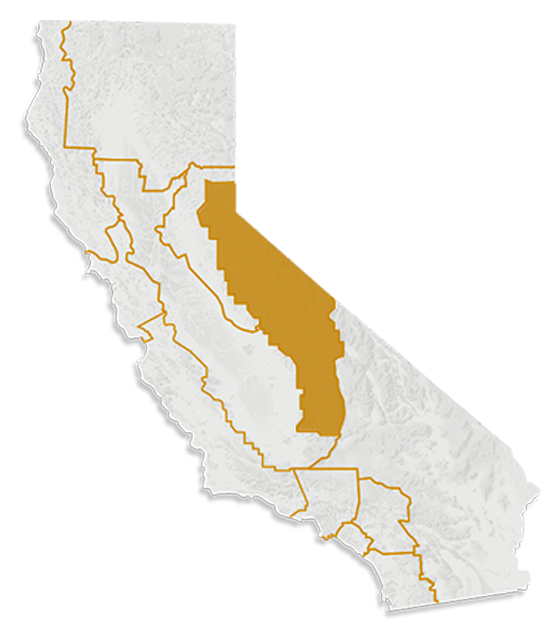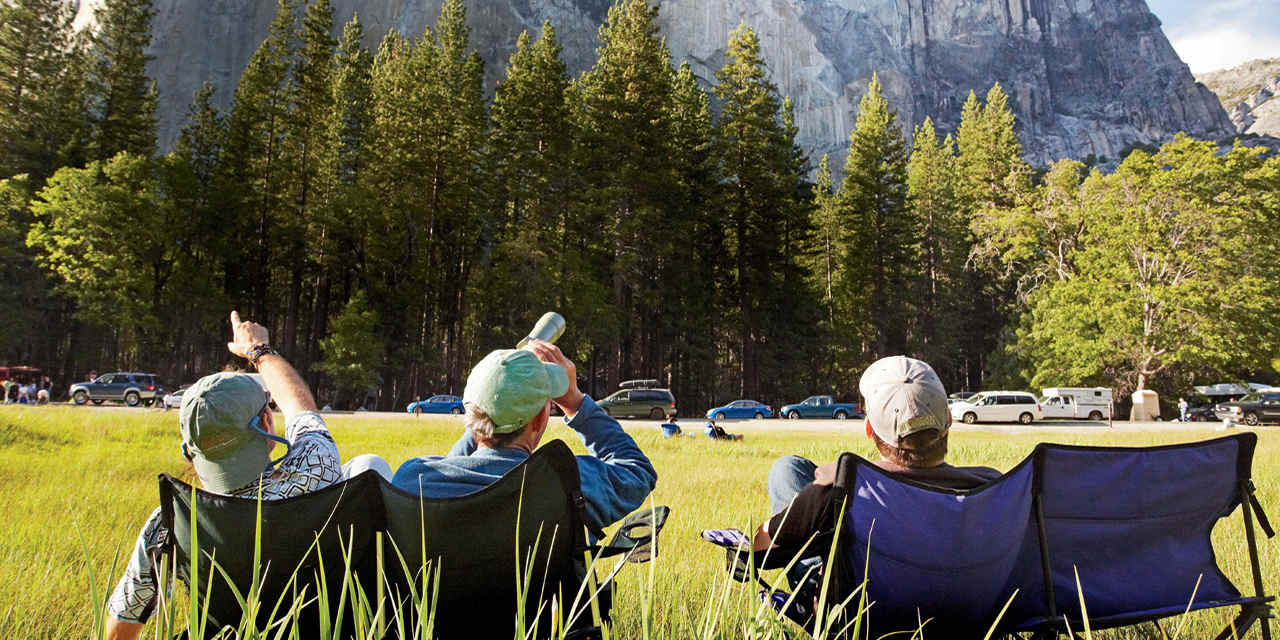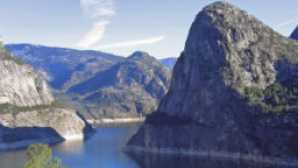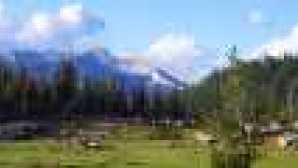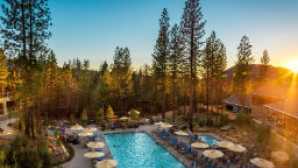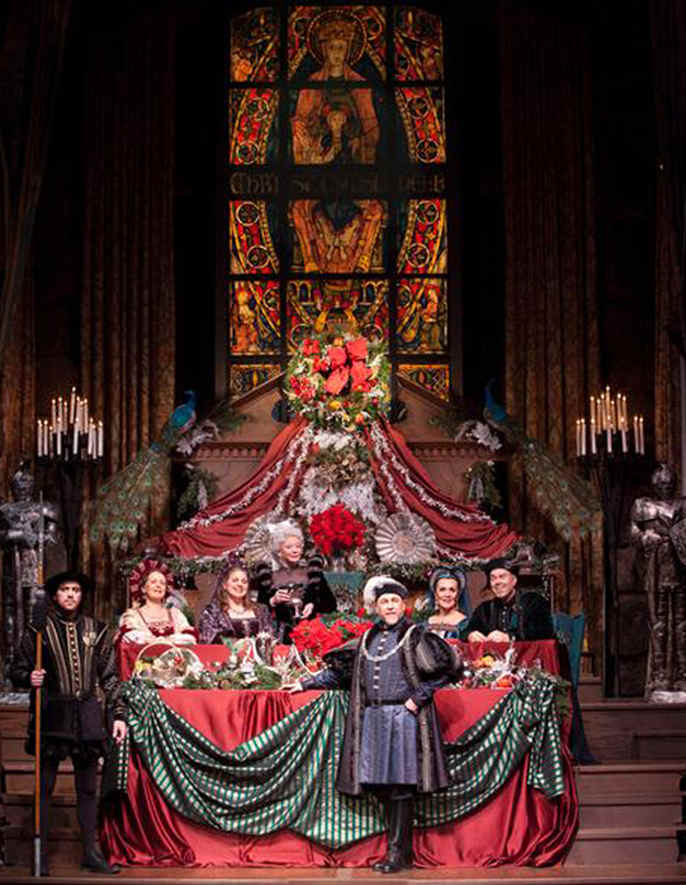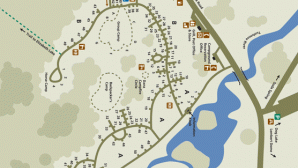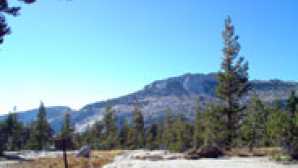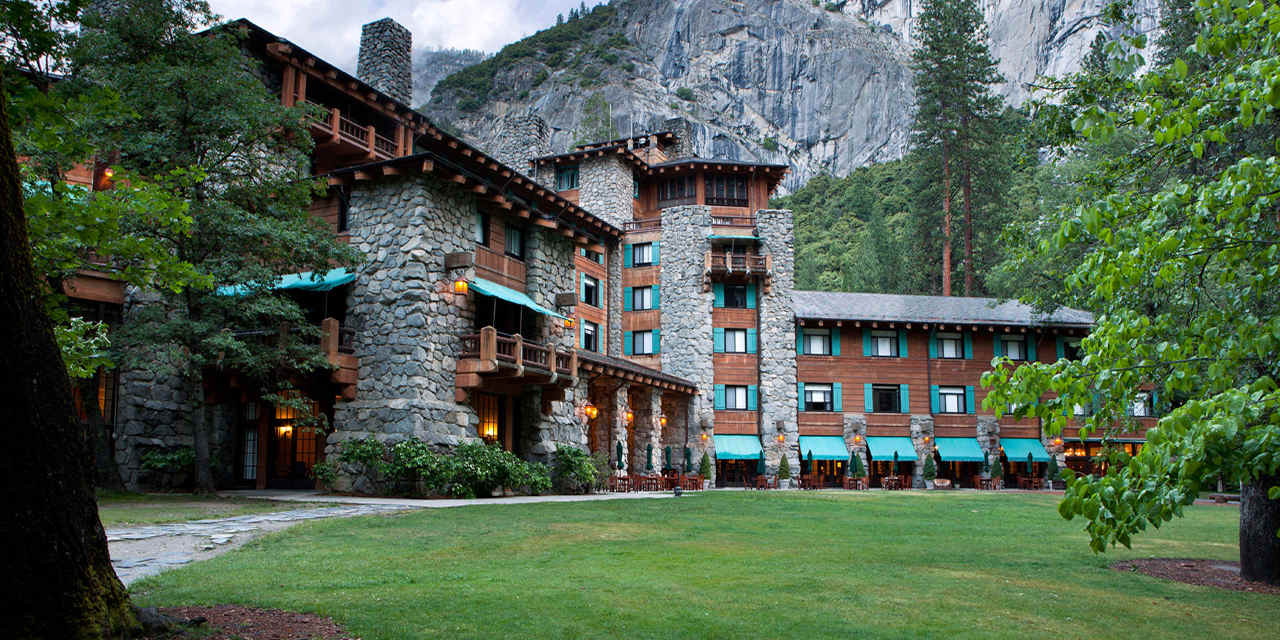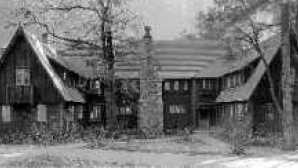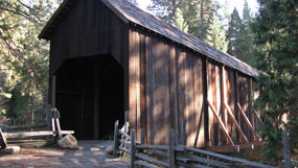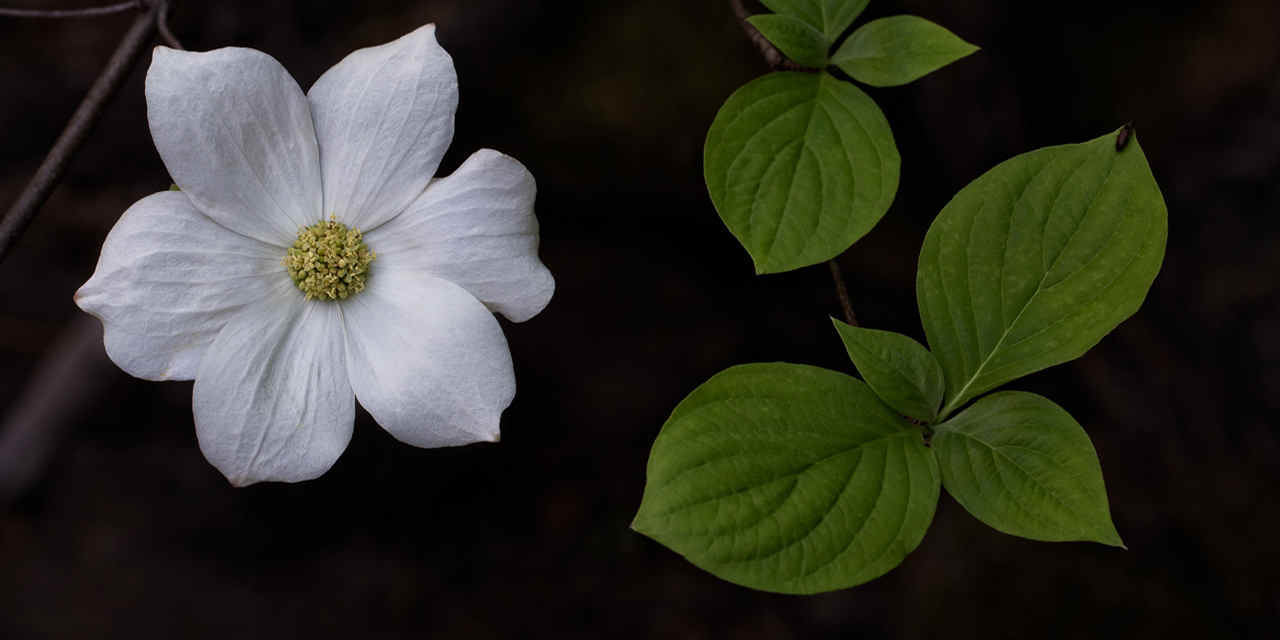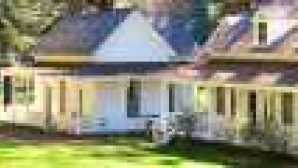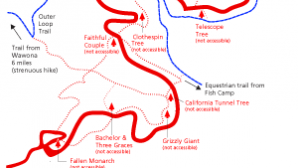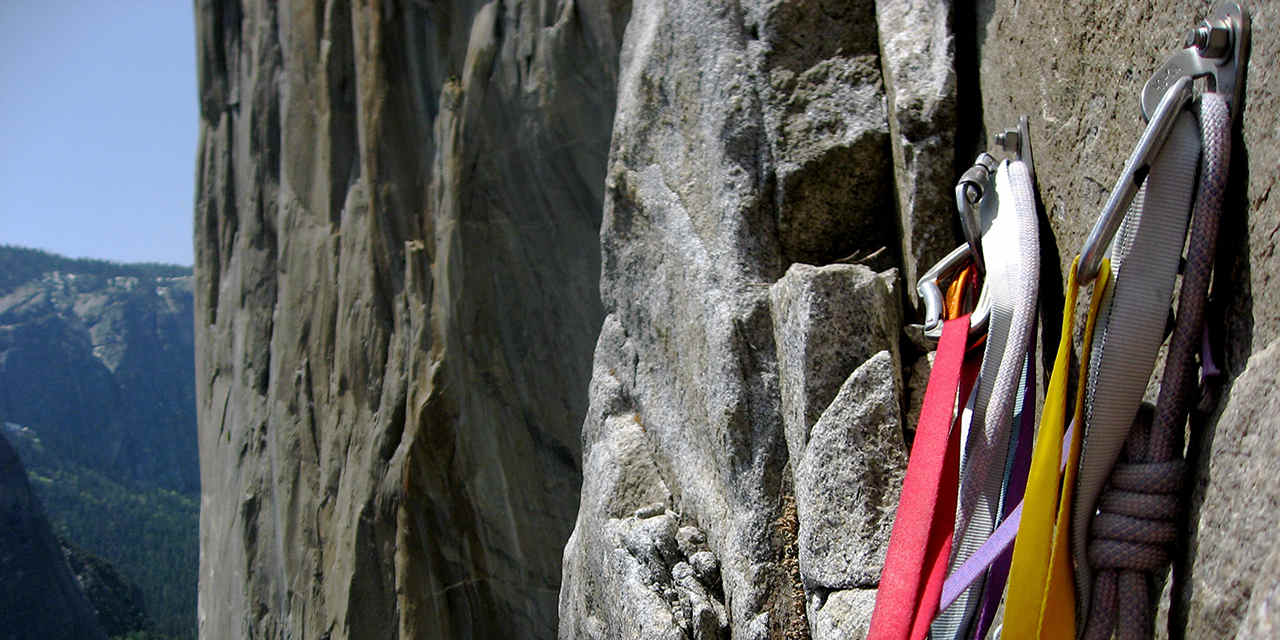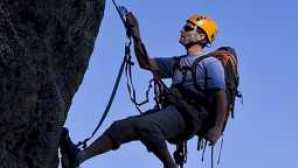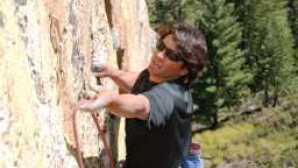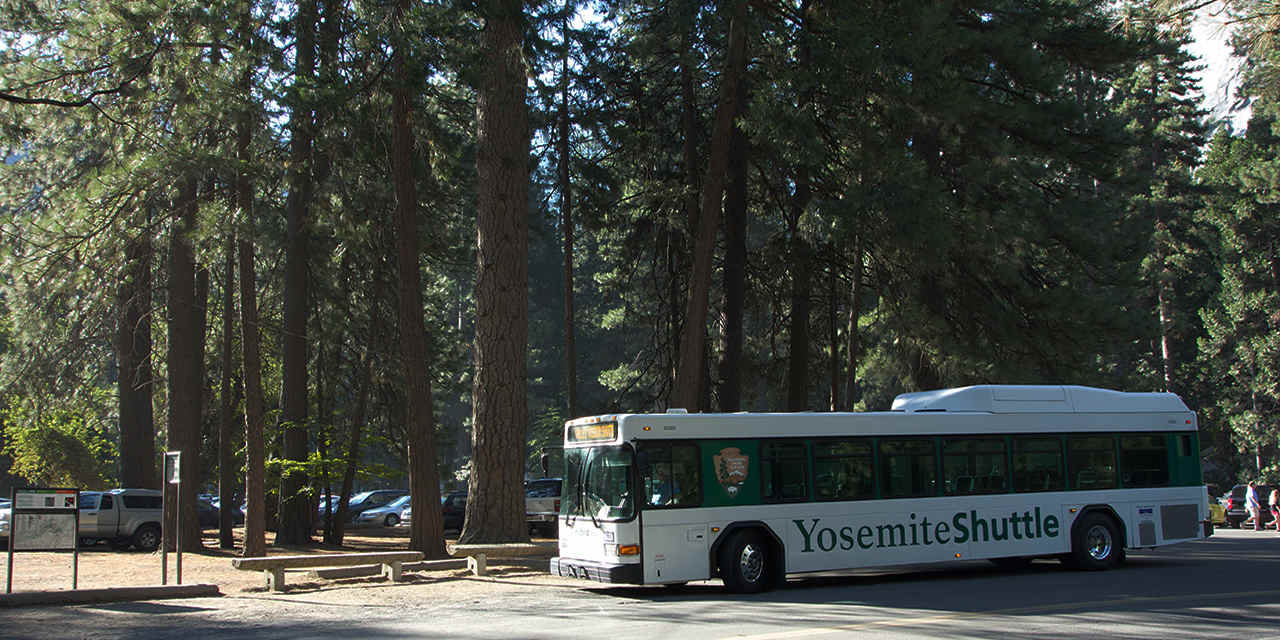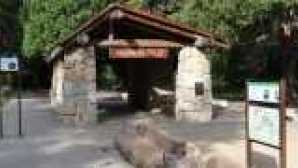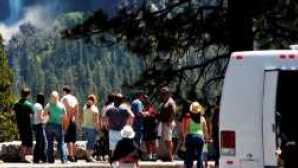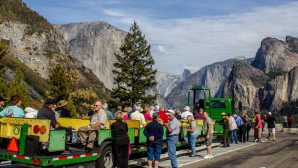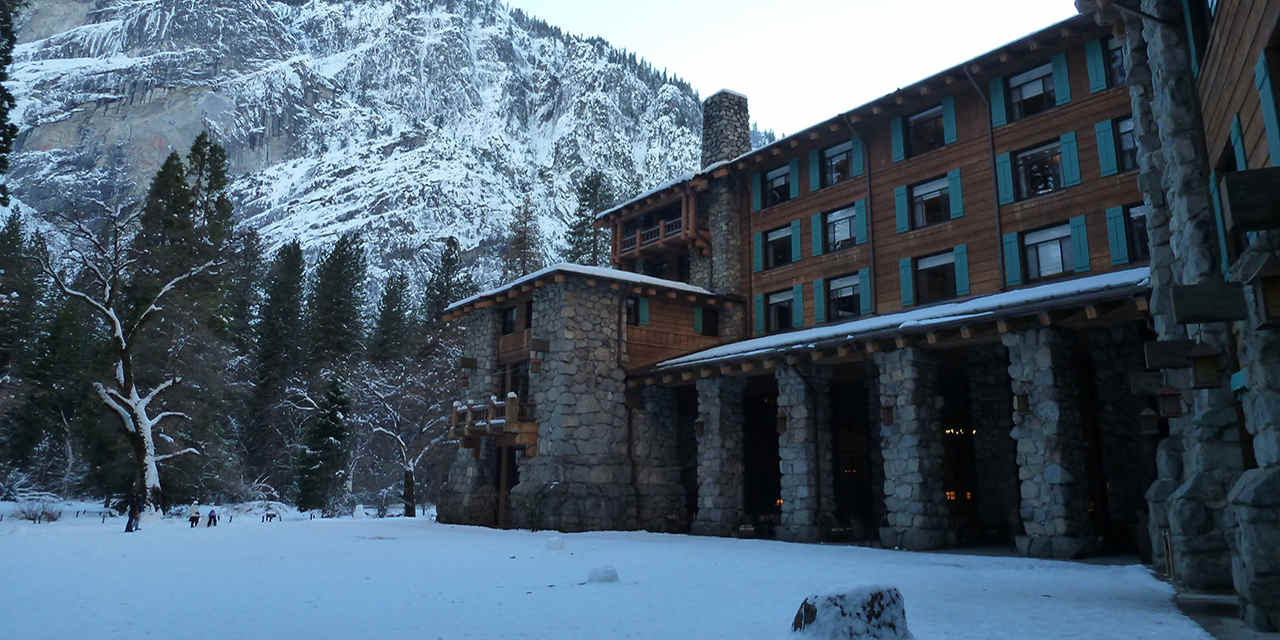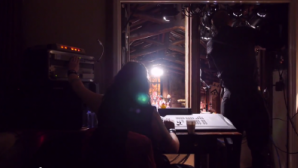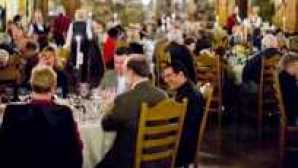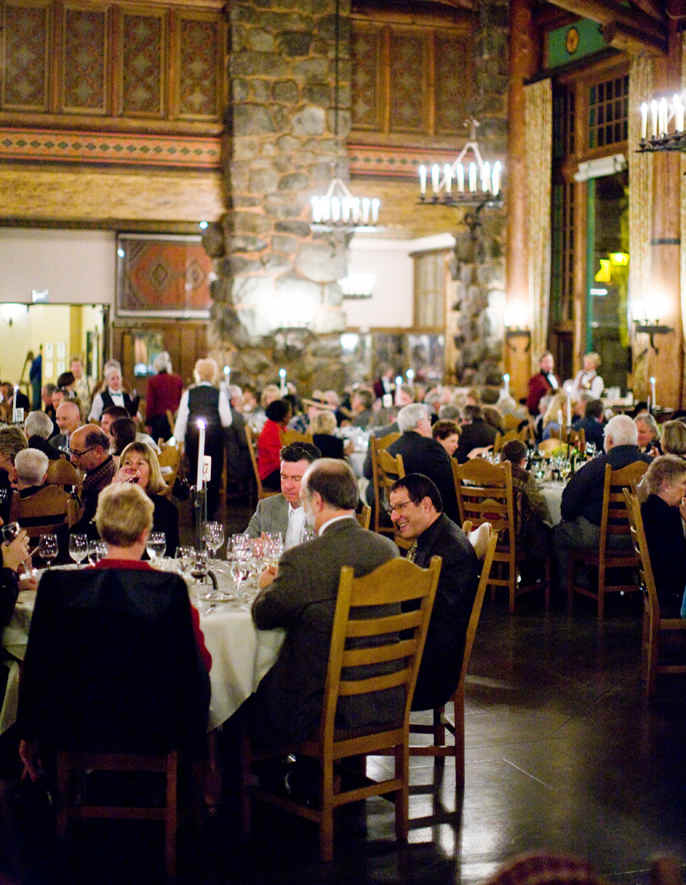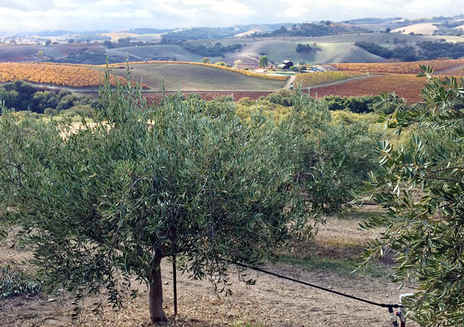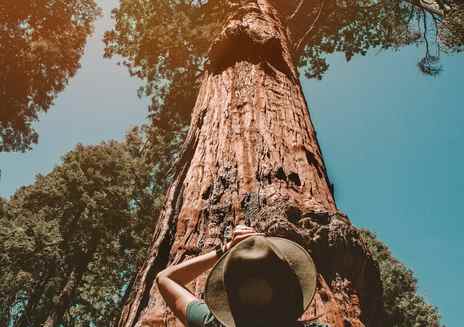For the latest on COVID-19 (Coronavirus) click here
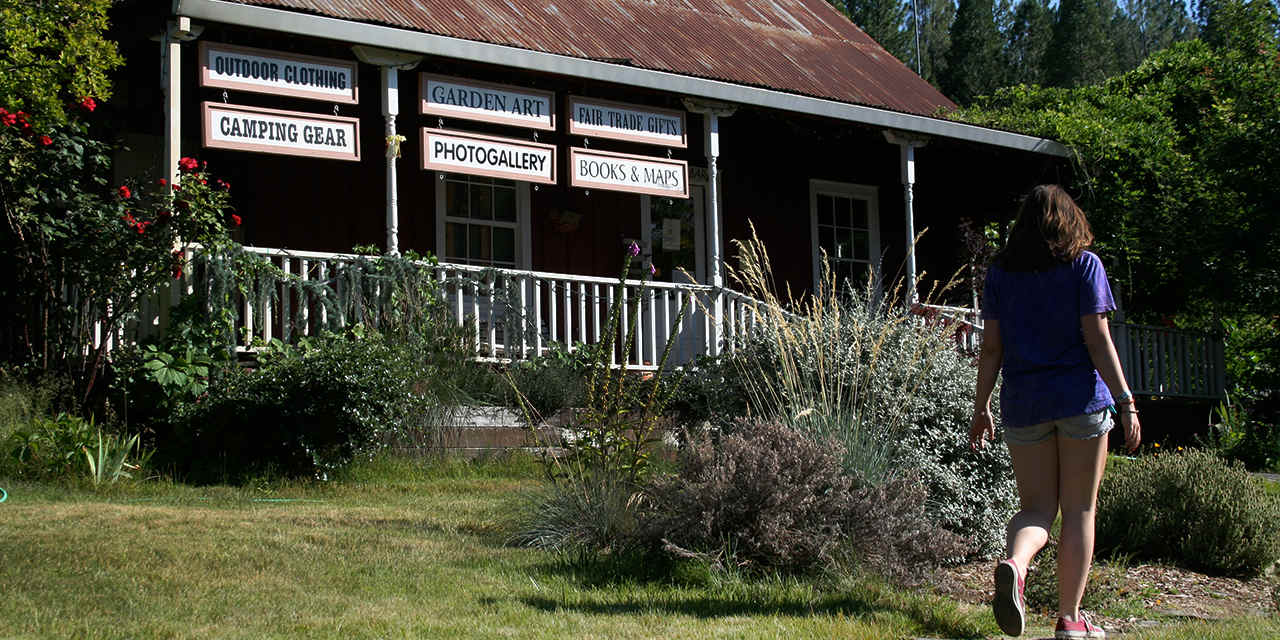
Yosemite's Gateway Towns
Central California
Spotlight: Yosemite National Park
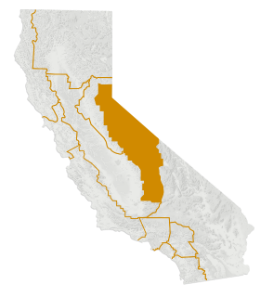
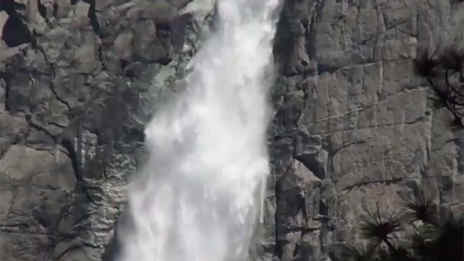
Famous for its plunging cataracts and massive granite formations, this unparalleled parkland attracts more than four million visitors each year—with good reason. Nearly the size of Rhode Island and covering more than 1,100 square miles/284,899 hectares, Yosemite National Park dazzles with unforgettable natural beauty.
Most visitors head directly to Yosemite Valley, a 4,000-foot/1,220-meter-deep trough lined by sheer cliffs of glacially sculpted rock. Although glacial valleys with similar features exist elsewhere in the world, none can compete with this one, which legendary naturalist John Muir called “the incomparable Valley.” The crystal-clear Merced River bisects its verdant meadows. Powerful waterfalls, fed by spring snowmelt, plunge over its sheer granite walls. A mélange of wildlife—black bears, mule deer, coyotes, chipmunks, and hundreds of bird species—make their home within the Valley’s monumental walls.
Organized park activities include open-air tram tours, ranger-led nature walks, evening theater performances, photography seminars, art classes, and rock-climbing lessons. When the Merced River quiets down to its summer flow, you can rent an inflatable raft and float gently three miles downriver, passing Instagram-worthy landmarks like El Capitan and Yosemite Falls. Pedal around Yosemite Valley’s floor on paved bike paths and watch the setting sun cast a rosy glow on the mighty Half Dome, with its singular sliced-in-half profile. Ride a tour bus or drive your car to Glacier Point, one of the grandest viewpoints in the West. Or just lace up your hiking boots and set out on any of dozens of hiking trails, like the celebrated Mist Trail to Vernal and Nevada Falls, or the easy Mirror Lake Loop.
Yosemite’s south side is anchored by the small community of Wawona and the Mariposa Grove of Giant Sequoias, a dense cluster of the world’s largest trees by volume. Take a walk among the stately sequoias, then take a dip in Wawona’s swimming holes or go for a horse-drawn carriage ride at the Pioneer Yosemite History Center. Spend the night at the 19th-century Wawona Hotel, an elegant reflection of days gone by.
In summer and fall, the park’s high-alpine country in and around Tuolumne Meadows is accessible via Tioga Pass Road. At 8,600 feet in elevation, this pristine meadow extends for more than two miles along the Tuolumne River, making it the largest subalpine meadow in the Sierra Nevada. Lace up your boots and wander trails to the summits of lofty domes and granite-backed lakes. Book in advance to join a multiday trekking trip through this alpine region and enjoy great meals and a comfy bunk at the famed High Sierra Camps.
For unforgettable snowy beauty, visit Yosemite during the park’s quietest season from November to March. Take part in ranger-led snowshoe walks, ice-skating at Curry Village, winter photography workshops, and holiday extravaganzas and culinary events at the park’s grand dame hotel, the Ahwahnee. Or make your way to Badger Pass Ski Area for alpine or cross-country skiing. If the weather feels too chilly for outdoor play, head to Yosemite Valley’s visitor center to learn about the region’s natural and human history and stop by the Ansel Adams Gallery to see works by one of California’s most acclaimed photographers.

5 Amazing Things to do in Yosemite’s Gateways
With its plunging waterfalls, alpine lakes, stark granite peaks, and verdant meadows, Yosemite National Park is a grand Sierra Nevada masterpiece. You might be in a hurry to get there, but don’t miss these surprising, off-the-radar attractions in the gateway towns surrounding the park. On your next Yosemite trip, linger a while in Fish Camp, Mariposa, Oakhurst, or Groveland and discover these delightful gems.
Yosemite Mountain Sugar Pine Railroad
Yosemite visitors typically travel by car or by foot, but it’s way cooler to ride in a vintage narrow-gauge steam train. The Yosemite Mountain Sugar Pine Railroad, just three miles beyond the park’s southern entrance in Fish Camp, brings to life memories of long-gone logging camps with its narrow-gauge steam train “The Logger.” Two beautifully restored steam locomotives—one built in 1913 and the other in 1928—pull rail cars with tree-carved bench seats along four miles of track in Sierra National Forest’s scenic woodlands. The narrated ride lasts about an hour and often includes a stop in the forest so riders can stroll and take photos. Keep on the lookout, though. On warm summer evenings, “masked bandits” on horseback stage mock train holdups, their six-shooters blazing.
Erna’s Elderberry House
Try to look away from the elegant furniture and Old World paintings so you can peruse the 725-bottle wine list at Erna’s Elderberry House, the in-house restaurant at Oakhurst’s fabulous five-star hotel, Château du Sureau. Three lavishly furnished dining areas set the scene for a multi-course prix fixe dinner or decadent Sunday brunch, prepared with the freshest local, seasonal, and organic ingredients from nearby Central Valley farms. After one meal here, you’ll be tempted to sign up for the chef’s half-day or three-day cooking classes. Named for the elderberries growing on the estate’s grounds, this haute-cuisine restaurant and adjoining inn were the vision of Austrian-born chef and interior designer Erna Kubin-Clanin. Since 2017, both are owned by hotelier Bernard Rosenson.
Yosemite Ziplines and Adventure Ranch
In Mariposa’s pastoral, oak-covered hills, about 40 miles from Yosemite’s Arch Rock/Highway 140 entrance, Yosemite Ziplines and Adventure Ranch serves up 30-mile-per-hour thrills. Book a spot on the two-hour tour, which includes a ride in a beefed-up Polaris Ranger to the top of the zipline course, followed by a soaring descent on six separate lines. First-timers have nothing to fear; you’re provided with safety gear and taught how to zip by experienced guides. Anyone of any age can go zipping as long as they weigh between 60 and 250 pounds. If you’re hankering for a triceps workout, spend an hour climbing around on the ropes course.
Rush Creek Lodge
Only a half-mile from Yosemite’s Big Oak Flat entrance on Highway 120, Rush Creek Lodge’s 143 woodsy-chic rooms offer a peaceful respite after a day of adventuring in the park. The lodge’s restaurant and tavern serve mountain-style comfort food—burgers, steaks, and seafood—plus a wealth of vegetarian options. In summer, you can dine by the lodge’s huge saltwater pool. There’s plenty to do on the 20-acre property including table tennis, shuffleboard, board games, family movie nights, and fire pits for evening s’more roasting, but the lodge’s biggest selling point is location—you can’t get closer to the Big Oak Flat entrance without being inside the park. An easy, scenic drive leads to either Yosemite Valley or Tuolumne Meadows. If Rush Creek is booked during your travel dates, try its sister property, Evergreen Lodge, about 15 minutes farther north.
Rainbow Pool
Looking for the perfect spot to take your kids swimming in a crystal-clear stream? Head for Rainbow Pool, a 20-foot waterfall and swimming hole on the South Fork of the Tuolumne River, off Highway 120 between Groveland and Yosemite’s Big Oak Flat entrance. In the days of stagecoach travel, Rainbow Pool was the site of a toll bridge over the South Fork. The toll-keeper’s cabin was perched on a rock promontory jutting out above the waterfall. Today, a paved path leads a few hundred feet down to the small beach edging Rainbow Pool. On every summer day, bold teenagers dive, jump, slide, and wade around the falls, while more cautious youngsters wade into the giant pool.
Things to do in Yosemite National Park
Known for its plunging waterfalls, giant sequoia trees, sheer granite cliffs, and more, you could easily spend weeks exploring Yosemite National Park. The park has a distinct appeal no matter what time of year—here, shoulder season simply means less people and a chance to see Yosemite's beauty from a different angle. Spring brings gushing waterfalls, summer allows for tackling all outdoor pursuits, fall boasts colorful trees and fewer crowds, and winter becomes a snowy wonderland for cross-country skiing and snowshoeing.
Getting around the park is made easier by the free Yosemite Area Regional Transportation System (YARTS), a public transit system that allows you to meander through the park car-free. Four routes connect to Yosemite from the gateway communities of Merced, Fresno, Mammoth Lakes, and Sonora (the latter three operate in summer only).
Plan ahead when you visit this storied destination to ensure the trip of a lifetime—here’s a guide to get you started.
El Capitan
Towering 3,593 feet above the Yosemite Valley floor, El Capitan is the undisputed king of the granite monoliths and a mecca for daredevil rock climbers. Get a good look at the earth’s largest single piece of granite from El Capitan Meadow. With a pair of binoculars, you can even watch the climbers inch their way up The Nose.
If you’re new to granite crack climbing or traditional climbing, sign up for a class with Yosemite Mountaineering School and Guide Service in Curry Village. The beginners’ “Welcome to the Rock” class will have you climbing and rappelling at heights of up to 60 feet on your first day. To learn more about Yosemite climbing, head over to the El Capitan Bridge and have a chat with one of the Yosemite Climbing Rangers. The “Ask a Climber” program (11 a.m.–3 p.m. in summer) is a daily gathering of rangers, climbers, and curious onlookers.
Merced River Rafting
Give your adrenaline a day off as you float gently down the lazy Merced River. Lie on your back in an inflatable raft, trail your fingers in the water, and gaze up at Yosemite’s granite walls as you meander downstream. Rent equipment at Curry Village, drop your boat in the water, and wave hello to El Capitan as you pass. (A shuttle bus takes you back to the start so you can conserve your energy for other park activities.)
Tuolumne Meadows
Lace up your boots and wander easy trails along the Tuolumne River or more rugged paths to the summits of lofty domes and granite-backed alpine lakes. Sleep in a tent cabin, nosh on a burger from the Tuolumne Grill, or attend a poetry gathering at the log-walled Parsons Lodge. Time your trip to Tuolumne Meadows carefully—this 8,600-foot high country is accessible only from June to October.
Yosemite Falls
Upper, Lower, and Middle Yosemite Falls combined make up the highest waterfall in North America, topping out at a prodigious 2,425 feet. A challenging trail accesses the upper fall’s crest, but the base of the lower falls can be visited with an easy stroll. From April to June, wear rain gear—an icy spray drenches all who come near.
Half Dome
One of the West’s most photographed landmarks, Half Dome inspires awe from every angle. Hardcore hikers can trek to its summit (permits are required); everybody else can admire its sheared-off granite from afar. Check out the perspective from Mirror Lake at the base of the stone monolith or drive up to the Washburn Point overlook on Glacier Point Road.
Wawona Tunnel View
The vista from Tunnel View is one of Yosemite’s most iconic scenes, made famous by an Ansel Adams photograph. From the Wawona Tunnel’s eastern side, shoot your own postcard-panorama of Yosemite Valley, El Capitan, Half Dome, and Bridalveil Fall. Or hike the Pohono Trail uphill for an even bigger view where you can enjoy the scenery in relative solitude.
The Ahwahnee Yosemite Dining Room
Grandeur rules at The Ahwahnee Dining Room. Bounded by massive timbered walls, its 34-foot-high ceilings are dotted with dozens of wrought iron chandeliers. Enormous picture windows framed by heavy draperies let in views of Yosemite Valley. The dining room seats 400 people—and there’s no bad seat in the house, especially at Sunday brunch.
Glacier Point
Glacier Point’s 7,214-foot overlook provides an unforgettable vista of Yosemite Valley and the High Sierra crest. Stand at the stone walls and survey Vernal and Nevada Falls and the Merced River canyon, or walk inside the granite Geology Hut to peer out at Half Dome. Best time to visit? Sunrise or sunset, when Half Dome and its granite neighbors turn pink.
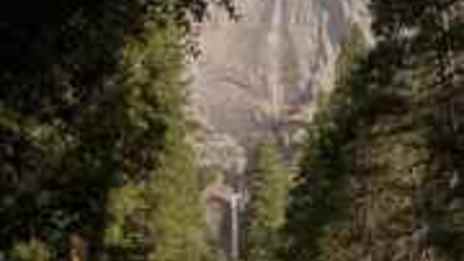
CALIFORNIA QUESTIONNAIRE: Alex Honnold
On June 3, 2017, Honnold became the first person to ever ascend El Capitan, the 3,000-foot granite wall in Yosemite National Park, without the use of ropes, a harness, or a safety net of any kind. His free-solo feat, long considered inconceivable within the rock-climbing world, sealed the 31-year-old’s status as the best rock climber who has ever lived. Climber, filmmaker, and Honnold’s close friend Jimmy Chin documented the climb, which took just under four hours, for a National Geographic feature story and feature film.
Honnold was born in Sacramento and grew up with the Sierra Nevada as his mountain playground. He began climbing when he was 11, and at 19 left his studies at UC Berkeley to devote himself to his rock-climbing pursuits. Yosemite has been a second home to Honnold, who has notched some of his greatest climbing achievements there, including a solo of Yosemite’s Triple Crown—Mt. Watkins, El Capitan, and Half Dome—while living out of his van.
Even Honnold doubted the probability of a totally unsupported ascent of “El Cap,” one of the world’s most iconic climbing destinations. “I think it’s important to let yourself feel that doubt, because I didn’t want to put pressure on myself,” he said, in a post-climb interview with Men's Journal. “But, I knew I had to at least practice it and see if it was possible, otherwise I’d have always wondered whether I could, or should, have gone for it.”
Despite the international celebrity that followed, Honnold has maintained his self-proclaimed “simple dirtbag-climber existence,” living in his van in his favorite place on earth.
Where do you live? I’m from Sacramento, but have spent basically my whole life traveling and living out of my van. I spend more time in Yosemite than any other place—often three months or more a year.
Why there? Yosemite has the best climbing on earth.
What is your greatest California love? The Sierra Nevada. I grew up there and spent my whole life playing in the mountains. The smell of the dry pine forest around Tahoe and the High Sierra—that feels like home to me. There are so many [climbing] opportunities with big mountains, and the rock is so good. The sheer walls in the Sierra are unlike any other mountain range in the United States. The whole Eastern Sierra just drops off with several thousand-foot walls. It’s amazing for climbing.
What is the biggest misperception about Californians? A lot of people just think about Hollywood, surf culture and the beach. Obviously, that is California, but for me it’s 100 percent mountain-focused.
What is the stereotype that most holds true? That there’s crazy traffic, especially in the Bay Area and Los Angeles.
What is your favorite Golden State splurge? There’s so much great food and fresh produce in California. The Mexican and Asian food is so good.
Time for a road trip—where are you going? I’d go up north on the coast. There’s a lot of rock up there I haven’t seen.
If you could decree an official state culinary experience, what would it be? I would decree Asian noodles. I love eating them. L.A. and the Bay Area are amazing for food and have the best options.
Best California song? "Californication" by the Red Hot Chili Peppers.
How would your California dream day unfold? I live my dream day. Wake up in Yosemite, pedal my bicycle down to El Capitan (which is the biggest rock wall in the world), and go climb it. Afterwards, I hang out with my friends in the Valley and socialize.
Hetch Hetchy Valley
In the spring, Yosemite National Park visitors flock to see thundering waterfalls and flashy wildflowers—an easy score in Yosemite Valley. But head to the park’s northwest corner in Hetch Hetchy Valley and you’ll witness spring’s splendor from a whole new perspective.
Hetch Hetchy—which conservationist John Muir called a “wonderfully exact counterpart” to Yosemite Valley—is, like its neighbor to the south, graced by sheer granite walls and multiple gushing cataracts. But Hetch Hetchy’s greatest charm may be what it lacks: gift shops, snack stands, and crowds.
An hour’s drive from Groveland via Highway 120 and Evergreen Road, Hetch Hetchy’s rugged cliffs frame an eight-mile-long reservoir that supplies San Francisco’s water. Its aqueous blue depth is held back by O’Shaughnessy Dam, a 1920s engineering marvel that took seven years to build—plus another 14 years to link the aqueducts and tunnels traveling 156 miles to San Francisco.
Hiking is a highlight here. Although peak summer temps can get toasty, this area of the park claims one of the longest hiking seasons. Stroll across the dam’s concrete crest and through a tunnel to access the two-mile trail to boisterous Wapama Falls, passing Tueeulala Falls along the way. Both cascades tumble more than 1,000 feet over polished granite before splashing into the deep blue lake. Carpets of purple larkspur, harlequin lupine, and pink farewell-to-spring paint the shoreline. To get a bird’s-eye view and a heart-rate spike, climb the steep switchbacks up Beehive Meadow Trail, with its edges lined with vivid floral displays.
After a hike, a microbrew might hit the spot, so drive nine miles from the trail to Evergreen Lodge. A cluster of ramshackle cabins built for the Hetch Hetchy dam workers in 1920, it is now a woodsy-chic cottage resort with a tavern, restaurant, and saltwater swimming pool. Spend the night so you can roast s’mores under the stars at the outdoor fire pits. Evergreen’s sister property, Rush Creek Lodge, offers additional rooms, suites, and hillside villas. Stay for a few days and you’ll have time to paddle the Wild and Scenic Tuolumne River, better known as the “T.” Eighteen miles of class IV rapids grace the river west of Hetch Hetchy. Biggest thrill: the three staircase drops of Clavey Falls.
Yosemite in Winter
With its iconic granite domes and spires etched in snow, and a hushed beauty that’s both intimate and wild, Yosemite National Park makes a magical—and surprisingly accessible—winter getaway. And with crowds a distant summer memory, you can relax and take time to enjoy the snowy finery.
“One of my favorite things about winter in the park is to walk around Yosemite Valley and see all of the families out building snowmen,” says Ashley Meyer, spokesperson for the park. “Some of these folks are experiencing snow for the first time—you can see the excitement in their eyes.”
But it’s by no means all DIY fun at Yosemite in winter. The park offers a full slate of seasonal activities: ranger-led snowshoe walks, special dinners, ice-skating at the valley’s Curry Village (formerly Half Dome Village), winter photography workshops, and starry night sky events. Go sledding at play areas near the park’s main entrance, or take the family skiing at the park's low-key ski area, near the historic Wawona Hotel(formerly the Big Tree Lodge) at the park's south entrance.
“You can’t get much more wintry than Yosemite’s Ostrander Ski Hut, a 1941 two-story stone structure nestled in a remote glacial cirque at an elevation of 8,500 feet.”
While some high-country routes do close for the winter (usually November through June or even later in heavy snow years), you can still get to the park—especially Yosemite Valley—on well-maintained roads. If storms do blow in, you might need 4WD or tire chains, so be prepared (check current road conditions here). Another option: Ditch the winter driving entirely and catch the daily Yosemite Area Regional Transportation System (YARTS) bus from Merced. Once you get to the park, you can expect everything from sunny, 60° F days to blustery winter storms and plunging temperatures, so pack accordingly.
If it gets too chilly for you, head to the Valley’s interpretive center to learn about natural and human history in the region. A small theater regularly shows the short movie Spirit of Yosemite, and exhibits fill the Indian Cultural Museum. Also stop by the Ansel Adams Gallery to see works by one of California’s photographic legends.
Most lodgings in and around the park stay open year-round, with many offering special events and packages. Plan well ahead to join annual Bracebridge Dinners—holiday extravaganzas with music and feasting—at the park’s grand dame hotel, The Ahwahnee (formerly The Majestic Yosemite). The Ahwahnee also hosts two multi-day events focusing on food and wine: Chefs Holidays and Vintners Holidays. The Wawona Hotel also stays open through winter, and it’s a great place to try cross-country skiing or snowshoeing. (Snowshoe and ski rentals and lessons are available at Yosemite Cross-Country Ski School.) And you can’t get much more wintry than Yosemite’s Ostrander Ski Hut, a 1941 two-story stone structure nestled in a remote glacial cirque at elevation 8,500 feet. The hut has basic overnight accommodations and cooking facilities for up to 25 adventurers who don’t balk at the 10-mile cross-country ski or snowshoe tromp from the cross-country ski school to reach the hut. It’s so popular, in fact, that it requires a lottery system for reservations.
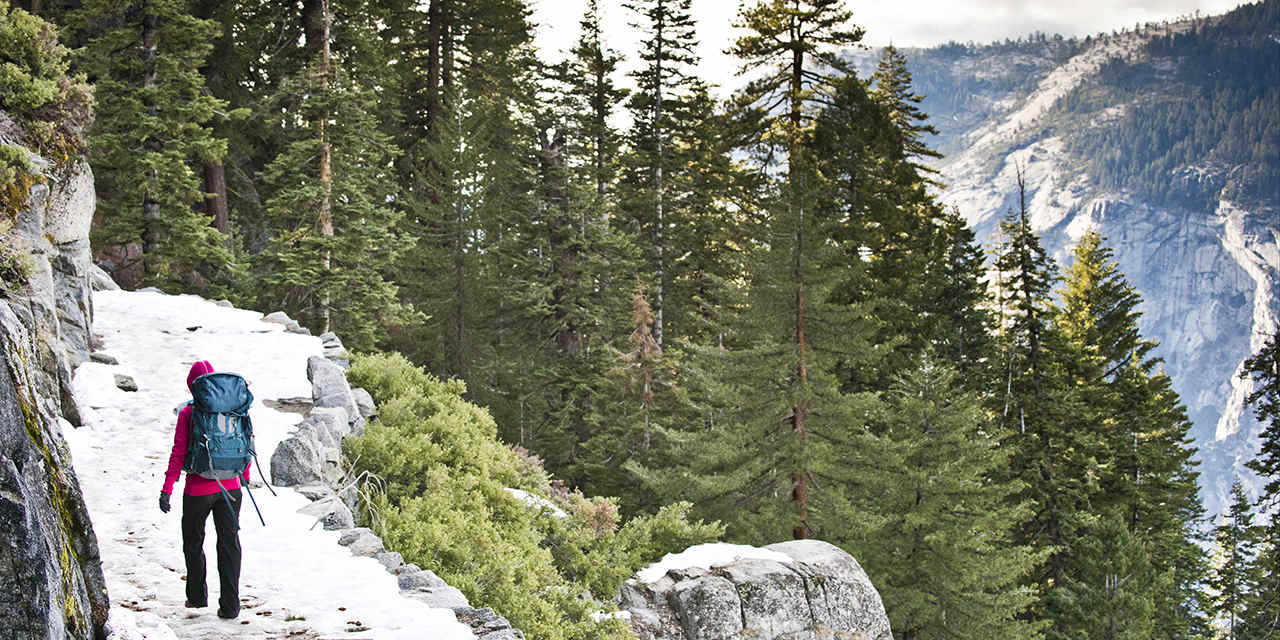
Glacier Point
The commanding vista from Glacier Point, a 7,214-foot/2,199-meter granite precipice that dramatically reaches out over Yosemite Valley, takes in the park’s most famous landmarks—Half Dome, Clouds Rest, Liberty Cap, Vernal and Nevada Falls, and the surrounding High Sierra. For many park visitors, it’s the single most I-gotta-take-a-picture spot in Yosemite. Getting to Glacier Point takes about an hour by car or bus from Yosemite Valley, or you can earn the view by hiking the strenuous-but-scenic Four-Mile Trail.
Glacier Point has an outdoor amphitheater for evening ranger talks, an imposing log cabin housing a snack stand and gift shop, and a small stone building known as the Geology Hut that was built in 1924 as a trailside museum. Now it’s a near-requirement for photo opps. The hut’s framed view of Half Dome, North Dome, and the Merced River canyon is unforgettable. Come here for sunset, when Half Dome blushes pink.
Along the road to Glacier Point are nearly a dozen trailheads for easy day-hikes. Families enjoy the easy Taft Point and Sentinel Dome trails, which begin at the same parking lot but head in opposite directions. Sentinel Dome, a granite dome at 8,122 feet/2,475 meters, offers a breathtaking perspective on Yosemite Falls as part of its 360-degree panorama. Taft Point’s view is completely different: a head-on look at El Capitan and a stomach-churning view of the Yosemite Valley floor, 3,500 feet/1,067 meters below. Hold on to the railing (and your kids!) while you peer over it.
Note that Glacier Point is closed by snow, typically November to early summer, but it’s a great route for snowshoeing or cross-country skiing.
Waterfalls and Firefalls
Among Yosemite’s many bragging rights, its waterfalls rank high. In the list of the world’s 20 tallest waterfalls, Yosemite Valley scores three spots for Yosemite Falls, Sentinel Fall, and Ribbon Fall. Yosemite Falls holds the undisputed title of the tallest waterfall in North America. It’s a challenging hike to the top of the 2,425-foot falls, but fortunately it’s an impressive view from the base to—an easy and scenic 1-mile loop that should be on everyone’s bucket list. Speaking of buckets, bring your rain gear April–June when snowmelt makes the falls boom, and overspray soaks much of the viewing area.
As for Yosemite’s other falls, they all have their undeniable allure. An easy walk to 620-foot Bridalveil Falls takes you to an overlook point below its billowing cascade. A more demanding hike to Vernal and Nevada Falls ascends granite steps to the brink of two massive drops, where you can watch the entire Merced River plunge over the rocky ledge. (Adhere to all safety signs and stay behind all ropes and signs.) On the park’s south side near Wawona, Chilnualna Falls tumbles over a series of granite ledges.
To see Yosemite at its watery best, time your trip for snowmelt—usually April to June. February, however, often offers a special treat: the Firefall, which looks like a stream of orange lava flowing down the side of El Capitan. It happens at Horsetail Fall, a waterfall east of Bridalveil and Ribbon falls, whose season typically lasts from winter through early spring.
The Firefall phenomenon, which tends to happen over the course of about three weeks, literally reflects the convergence of clear skies and the right amount of snowmelt. As sunset nears, the mist catches the sun rays and creates a fabulous optical illusion that lasts up to 10 minutes, making for some dazzling pictures. Get the best views from the El Capitan Picnic Area, less than two miles from Yosemite Valley Lodge (formerly the Yosemite Lodge). Celebrate afterward with a Firefall cocktail (hot chocolate with tequila, crème de cocoa, and pasilla chile) at the lounge in the Ahwahnee Hotel.
Experience one of California’s most magical winter settings, The Ahwahnee Hotel (formerly The Majestic Yosemite Hotel),...
Yosemite Valley
This geologic marvel, a 4,000-foot/1,220-meter-deep trough lined by towering cliffs and glacially sculpted, polished rock, is the prized jewel of Yosemite National Park. Although glacially carved valleys with similar features exist elsewhere in the world, none can compete with what legendary naturalist John Muir called “Incomparable Valley.”
"Take a seat to watch the setting sun cast its rosy glow on world-famous Half Dome"
Besides it’s natural beauty, Yosemite Valley is home to black bears, mule deer, and chipmunks—along with several hundred year-round park employees and thousands of visitors throughout the year. Newcomers may be surprised to find Yosemite Valley has a dentist’s office, jail, courtroom, auto garage, and church, as well as the more expected mix of lodgings, campgrounds, restaurants, and other guest services. For visitors, there’s no shortage of things to do. Organized activities run the gamut from ranger-led nature walks to evening theater, from ice skating to photography seminars, from Indian basket making to rock climbing lessons and river rafting. To create your own adventure, set out on one of dozens of hiking trails, pedal paved bike paths to Mirror Lake and other sites, or just take a seat to watch the setting sun cast its rosy glow on world-famous Half Dome.
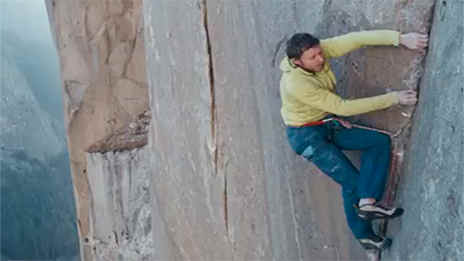
Enter Yosemite Valley to travel back in time to Christmas Past. Heraldic horns sound throughout Yosemite National Park's elegant...
Tuolumne Meadows
One of the most photographed regions of Yosemite, Tuolumne Meadows is a wide, grassy expanse bounded by high granite domes and peaks. At elevation 8,600 feet, pristine meadow extends for more than two miles along the Tuolumne River, making it the largest subalpine meadow in the Sierra Nevada. From its tranquil edges, hiking trails lead in all directions—to the alpine lakes set below the spires of Cathedral and Unicorn Peaks, to a series of roaring waterfalls on the Tuolumne River, and to the summits of lofty granite domes with commanding vistas of the high country.
While Tuolumne (too-ALL-uh-me) is the cornerstone of a vast playground for hikers, rafters, and backpackers, it’s also a great spot for visitors who simply want to take in the scenery. The meadow’s small visitor center, housed in a historic cabin, features exhibits that focus on the area's geology, wildflowers, and wildlife.
Want to picnic? In summer, visit the highest elevation convenience shop in the state: the remarkable Tuolumne Meadows Store, with groceries, bug repellent, clothing items, maps, and guidebooks housed in a seasonal canvas tent. Under the same tent is the Tuolumne Meadows Grill, serving hearty breakfasts and lunches, including unforgettable buckwheat pancakes. Ice cream cones are big sellers on warm afternoons.
Nearby, the Tuolumne Meadows Lodge offers tent-style overnight accommodations and sit-down meals, and Tuolumne Meadows Campground has more than 300 campsites, half of which are reservable and the other half available on a first-come, first-serve basis from approximately July through late September.
The Ahwahnee
It costs a bundle to spend the night, but there’s no charge for wandering inside, taking in the splendor of this 1920s-era hotel. This National Historic Landmark in Yosemite Valley has several “public rooms” where visitors can soak up its 1927 architecture, designed by Gilbert Stanley Underwood. Everything in The Ahwahnee (recently called the Majestic Yosemite Hotel) is built on a grand scale, from the massive hand-stenciled timber beams to sandstone fireplaces so large you could hold a tea party inside. Adorning this hefty structure are colorful stained-glass windows, Native American tapestries and baskets, Turkish kilim rugs, and Yosemite-inspired 19th-century paintings depicting the park’s waterfalls and giant sequoia trees.
Many famous people have slept in The Ahwahnee Yosemite, including John F. Kennedy, Greta Garbo, Queen Elizabeth II, and Winston Churchill. It’s a worthy splurge to stay in one of its 123 rooms, suites, or cottages, but even if you don’t, you can still book a table for the sumptuous Sunday brunch at The Ahwahnee Dining Room, or simply sit by the fireplace in the Great Lounge, look up at the wrought-iron chandeliers dropping from the dining room’s 34-foot, richly painted ceilings, or enjoy a cocktail at the bar. Free one-hour guided tours of The Ahwahnee Yosemite are offered throughout the year; check with the hotel's concierge desk for a current schedule.
Wawona & Mariposa Grove
When the Native Americans traveled between the foothills and Yosemite Valley, Wawona was the halfway point on their journey. They called it Pallachun, meaning “a good place to stay.” This Indian encampment is now the small community of Wawona, home to the historic The Wawona Hotel (formerly known as the Big Tree Lodge) and a private community of mountain cabins, many available to rent. Stay overnight (to relax on the wide veranda on one of the hotel’s Adirondack chairs is a Sierra rite of passage), or just spend a day in the area.
The hotel reflects its 19th century roots with lights and other details that echo the elegance of the era.
In summer, take a dip in nearby swimming holes, follow the switchback hiking trail to Chilnualna Falls, and get a history lesson at Pioneer Yosemite History Center (and take a horse-drawn carriage ride). The hotel itself has a small visitor center with information on more area activities. In the evening, pianist and singer Tom Bopp performs vintage songs—from cowboy tunes to sentimental ballads—that span Yosemite's history.
Wawona is also adjacent to Yosemite National Park’s south entrance—which, as of summer 2018, also offers good access to the magnificent Mariposa Grove. The oldest of Yosemite’s sequoia groves, Mariposa dates back to 1864, when Congress passed legislation to permanently preserve both the grove and Yosemite Valley. The grove’s recent restoration was designed to revive ecological processes, protect wildlife, and minimize the impact of car traffic on the 500 mature giant sequoias. The restored grove has a consolidated parking area, farther away from the trees (catch the shuttle from the south entrance), and some roads have been turned into hiking trails, including a boardwalk walkway. You can also see giant sequoias in other parts of Yosemite: Visit Tuolumne Grove, on the Tioga Road just east of Crane Flat, and Merced Grove, located on Big Oak Flat Road east of the Big Oak Flat Entrance.
Rock Climbing in Yosemite
Yosemite is well known as a mecca for rock climbers, but even experienced climbers can be daunted by their first glimpse at Yosemite Valley's massive vertical walls. Tuolumne Meadows, the other big climbing draw to the park, has numerous granite domes and formations like Cathedral Peak and the Matthes Crest, a mile-long granite fin with sheer drops of 500 feet. For hands-on instruction, sign up with Yosemite Mountaineering School and Guide Service, which conducts seminars and classes for beginning, intermediate, and advanced climbers from mid-April to October each year. Classes meet daily in Yosemite Valley and Tuolumne Meadows; equipment rentals are available. Yosemite Mountain Shop, located in the park, also has climbing gear for purchase.
"Scan the face of massive El Capitan ('The Captain' in Spanish) to see impossibly tiny climbers ascending the almost sheer face."
If you'd rather watch rock climbers than do it yourself, head to El Capitan Meadow. Set up a camp chair and scan the face of massive El Capitan (“The Captain” in Spanish) to see impossibly tiny climbers ascending the almost sheer face. Ever since this 3,593-foot rock face was first climbed successfully in the 1950s, a succession of bold adventurers have inched their way to the top. Most do it in three to five days; their nights are spent sleeping on ledges or tethered into hammocks (watch for the glimmer of their headlamps as they get ready to tuck in for the night). However, a brazen new breed of speed climbers has completed the ascent of “The Nose,” one of El Cap’s best-known climbing routes, in just a few hours. But speed isn't the only way climbers have distinguished themselves on this rock. Climbers Tommy Caldwell and Kevin Jorgeson made history in January 2015 when they became the first to free-climb El Cap's Dawn Wall, long considered the most difficult rock climb in the world. The remarkable feat, in which climbers only use ropes and harnesses for safety and depend solely on their strength and talent to ascend, took 19 grueling days.
Useful info: Visit Yosemite’s website for the park’s climbing regulations, and find out more about things to do in Tuolumne county.
Getting Around the Park
Want someone else to drive you around Yosemite? Smart idea. The park offers a wide range of public transportation, from free shuttle buses to fee-based tours. Free shuttles run throughout Yosemite Valley daily (until 10 p.m. in summer), shorter hours in winter. Simply hop on the shuttles at any one of 19 stops; buses run about every 10 to 20 minutes. Free shuttle buses also access Highway 120, the Tioga Pass Road, in summer.
The park’s most popular fee-based tour is the year-round Valley Floor Tour, a two-hour, 26-mile trip through Yosemite Valley, offering easy viewing of famous sights like Yosemite Falls, Half Dome, El Capitan, and Bridalveil Falls. A guide narrates the tour while you sit in an open-air tram and enjoy unobstructed views. (In winter, the tour takes place in an enclosed bus.) Other routes access Glacier Point, Wawona, Mariposa Grove, and Tuolumne Meadows. Great tip for hikers: take the bus to Glacier Point or Tuolumne Meadows, then hike back to the valley.
To really leave the driving to someone else, consider getting to the park via public transit. The Yosemite Area Regional Transportation System (YARTS) operates year-round on Highway 140 out of Merced, with summer service from the north in Sonora and from the east in Mammoth Lakes. Each route has multiple stops, including in gateway towns. Once you arrive at Yosemite, you can use the park’s shuttle system.
Yosemite's Gateway Towns
Getting to Yosemite can add a lot to your trip—if you take time to explore the historic towns on your way to the park. Many of these Gold Rush–era communities have seen a jolt of new energy, thanks in part to booming wine country, a new focus on farm-to-table dining and food products, and a growing interest in leaving big cities to create new lives in smaller, rural communities with strong bonds and wide-open spaces and opportunities. Here are a few worthwhile stops on the major routes into the park:
Highways 49 and 120: Visit Sonora and nearby Columbia State Historic Park, with outstanding recreations of Gold Rush-era life and a chance to try your hand at gold-panning. Continue south to Jamestown to board an antique steam locomotive for a ride around Railtown 1897 State Historic Park. At Highway 120, climb to the alpine town of Groveland and the Iron Door Saloon, a onetime post office building that has welcomed folks on their way to and from Yosemite since 1896.
Highway 120 (Tioga Pass): This spectacular drive over the Eastern Sierra and 9,945-foot Tioga Pass leads to the trails, granite domes and wildflowers of Tuolumne Meadows. Before you start the climb east from Lee Vining, or if you are heading to the park from Mammoth Lakes (about 25 miles south on U.S. 395), visit Mono Lake Tufa State Natural Reserve and its otherworldly limestone formations, then tuck into a meal at one-of-a-kind Whoa Nellie Deli. Note: Highway 120 (and the deli) close for winter, typically November to May).
Highway 41: Climb from Fresno and into rolling foothills and the Madera Wine Trail, with more than a dozen vineyards and friendly tasting rooms. Next up is Oakhurst and the remarkable Château du Sureau luxury lodging and companion restaurant, Erna’s Elderberry House Restaurant. Nearby, justly popular Bass Lake feels a bit like a mini Lake Tahoe, with boating, fishing, and lakeside lodging and camping. Beyond Oakhurst, Highway 41 winds and climbs nearly 3,000 feet to tiny Fish Camp, (population 59), where you can ride the scenic Yosemite Mountain Sugar Pine Railroad. Less than a mile away, at Tenaya Lodge at Yosemite, take in a “cabineering” experience at one of their 50 well-appointed, two-bedroom Explorer Cabins. From Wawona, eight miles further along Highway 41, continue to El Portal and the legendary Tunnel View, a panoramic vista of Yosemite Valley that takes the breathe away of even the most seasoned Sierra traveler.
Highway 140: From Merced, Highway 140 leads to the wineries of the Sierra Foothill appellation, known for rich, chocolate-y Zinfandels. In the town of Mariposa, see a nearly 14-pound crystalline gold nugget at the California State Mining and Mineral Museum. The route then follows the wild and scenic Merced River before reaching El Portal on the national park boundary.
Ahwahnee Winter Events
Heading the bill each winter at the Ahwahnee (formerly the Majestic Yosemite Hotel) are the annual Bracebridge Dinners, lavish Christmas celebrations featuring more than 100 performers and a seven-course feast, all of it prepared, served, and presented in a way that will transport you to 18th-century England. The December show, a loose adaptation of an episode from Washington Irving's Sketch Book, has been held every year at the Ahwahnee since 1927. The four-hour program features music from the Middle Ages, Renaissance rituals, traditional yuletide decorations, and plentiful food, song, and mirth. The event is held for less than a dozen nights in mid- to late December, so tickets tend to sell out fast.
Other winter events at the Ahwahnee include the New Year’s Eve gala, which features a six-course meal, live music , and dancing; celebrations are also held that night at sister Yosemite venues Yosemite Valley Lodge and The Wawona Hotel.
Two annual winter events revel in the region’s excellence in the realm of the delectable: the Grand Grape Celebration and Taste of Yosemite. For both, the hotel’s Great Lounge is transformed into a culinary classroom. The Grand Grape Celebration—a toast to winemakers’ fall harvests with two-day sessions of wine tastings, seminars, and a gala five-course dinner—is held in November and December. At Taste of Yosemite in November, California's finest chefs strut their stuff during an hour-long skills demonstration; the master culinarians then prepare a dinner for all. One of the perks for attendees is insider access to the Ahwahnee's kitchen. Beneath its 35-foot ceilings are food-related antiques like the original 1927 walk-in refrigerators, which were kept cool with 500-pound blocks of ice from nearby Mirror Lake, and the 80-plus-year-old oven, where all the hotel’s bread is still baked.


